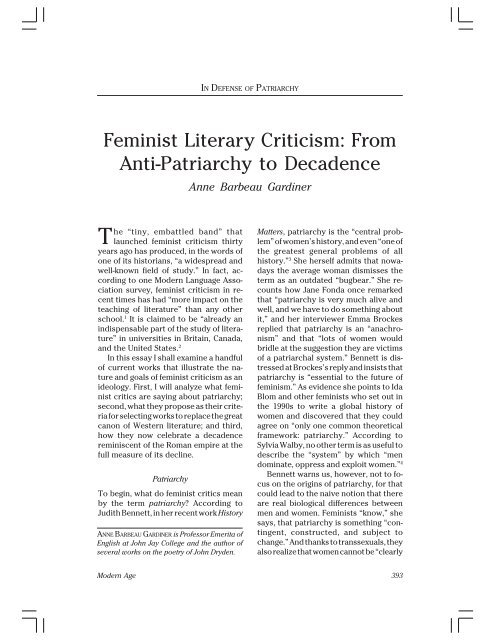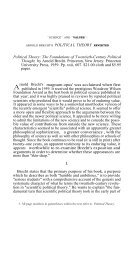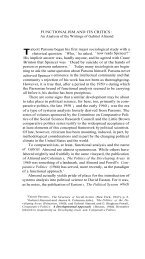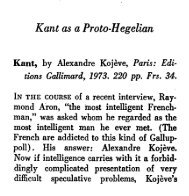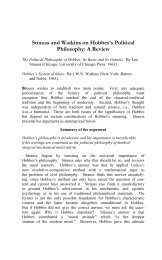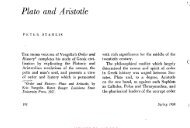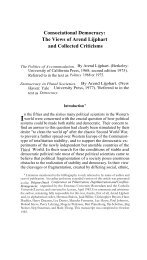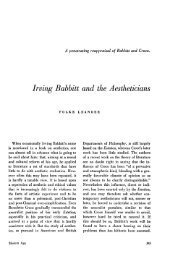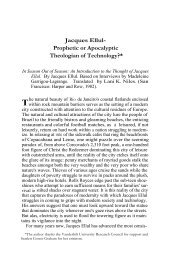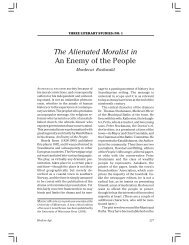Feminist Literary Criticism: From Anti-Patriarchy to Decadence
Feminist Literary Criticism: From Anti-Patriarchy to Decadence
Feminist Literary Criticism: From Anti-Patriarchy to Decadence
Create successful ePaper yourself
Turn your PDF publications into a flip-book with our unique Google optimized e-Paper software.
IN DEFENSE OF PATRIARCHY<br />
<strong>Feminist</strong> <strong>Literary</strong> <strong>Criticism</strong>: <strong>From</strong><br />
<strong>Anti</strong>-<strong>Patriarchy</strong> <strong>to</strong> <strong>Decadence</strong><br />
Anne Barbeau Gardiner<br />
The “tiny, embattled band” that<br />
launched feminist criticism thirty<br />
years ago has produced, in the words of<br />
one of its his<strong>to</strong>rians, “a widespread and<br />
well-known field of study.” In fact, according<br />
<strong>to</strong> one Modern Language Association<br />
survey, feminist criticism in recent<br />
times has had “more impact on the<br />
teaching of literature” than any other<br />
school. 1 It is claimed <strong>to</strong> be “already an<br />
indispensable part of the study of literature”<br />
in universities in Britain, Canada,<br />
and the United States. 2<br />
In this essay I shall examine a handful<br />
of current works that illustrate the nature<br />
and goals of feminist criticism as an<br />
ideology. First, I will analyze what feminist<br />
critics are saying about patriarchy;<br />
second, what they propose as their criteria<br />
for selecting works <strong>to</strong> replace the great<br />
canon of Western literature; and third,<br />
how they now celebrate a decadence<br />
reminiscent of the Roman empire at the<br />
full measure of its decline.<br />
<strong>Patriarchy</strong><br />
To begin, what do feminist critics mean<br />
by the term patriarchy? According <strong>to</strong><br />
Judith Bennett, in her recent work His<strong>to</strong>ry<br />
ANNE BARBEAU GARDINER is Professor Emerita of<br />
English at John Jay College and the author of<br />
several works on the poetry of John Dryden.<br />
Matters, patriarchy is the “central problem”<br />
of women’s his<strong>to</strong>ry, and even “one of<br />
the greatest general problems of all<br />
his<strong>to</strong>ry.” 3 She herself admits that nowadays<br />
the average woman dismisses the<br />
term as an outdated “bugbear.” She recounts<br />
how Jane Fonda once remarked<br />
that “patriarchy is very much alive and<br />
well, and we have <strong>to</strong> do something about<br />
it,” and her interviewer Emma Brockes<br />
replied that patriarchy is an “anachronism”<br />
and that “lots of women would<br />
bridle at the suggestion they are victims<br />
of a patriarchal system.” Bennett is distressed<br />
at Brockes’s reply and insists that<br />
patriarchy is “essential <strong>to</strong> the future of<br />
feminism.” As evidence she points <strong>to</strong> Ida<br />
Blom and other feminists who set out in<br />
the 1990s <strong>to</strong> write a global his<strong>to</strong>ry of<br />
women and discovered that they could<br />
agree on “only one common theoretical<br />
framework: patriarchy.” According <strong>to</strong><br />
Sylvia Walby, no other term is as useful <strong>to</strong><br />
describe the “system” by which “men<br />
dominate, oppress and exploit women.” 4<br />
Bennett warns us, however, not <strong>to</strong> focus<br />
on the origins of patriarchy, for that<br />
could lead <strong>to</strong> the naive notion that there<br />
are real biological differences between<br />
men and women. <strong>Feminist</strong>s “know,” she<br />
says, that patriarchy is something “contingent,<br />
constructed, and subject <strong>to</strong><br />
change.” And thanks <strong>to</strong> transsexuals, they<br />
also realize that women cannot be “clearly<br />
Modern Age 393
identified” by their bodies: “There is, in<br />
other words, no stable subject, no coherent<br />
thing called ‘women’—at the heart of<br />
either feminism or feminist his<strong>to</strong>ry.” 5 For<br />
Bennett the words patriarchy and women<br />
are useful constructs in a power-struggle,<br />
but they have no referents in nature, biology,<br />
or objective reality.<br />
Her view goes back <strong>to</strong> Simone de<br />
Beauvoir, who in The Second Sex presented<br />
women’s nature as something<br />
constructed by patriarchy, but so cunningly<br />
done that the construction looked<br />
like nature and was thought <strong>to</strong> be unchangeable.<br />
Such a denial of nature is<br />
now current in feminist ideology. Ruth<br />
Robbins, in her recent work <strong>Literary</strong> Feminisms,<br />
lists among the oppressions women<br />
have endured by being “formed under<br />
patriarchy,”<br />
physiological oppressions which attack<br />
women by virtue of their bodies (childbearing<br />
and rearing defined as “women’s work,”<br />
or the fact that women are physically less<br />
powerful than men, and can be subjected <strong>to</strong><br />
violence and rape). 6<br />
Note well that Robbins accuses patriarchy<br />
of having defined “childbearing” as<br />
“women’s work” and thus having deceived<br />
unsuspecting females for millennia. Without<br />
this construction, who knows if<br />
women would ever have stumbled on<br />
motherhood? Similarly, in the recently<br />
published Cambridge Companion <strong>to</strong> <strong>Feminist</strong><br />
<strong>Literary</strong> Theory, Nancy Armstrong<br />
declares that the “power” women had<br />
over “child-rearing” in the nineteenth<br />
century was “in no way natural” <strong>to</strong> them. 7<br />
Not natural because for feminist critics,<br />
every phase of motherhood (except abortion)<br />
is a patriarchal conspiracy <strong>to</strong> oppress<br />
women. Welcome <strong>to</strong> the paranoia<br />
that passes for “truth” among these ideologues,<br />
“where there is no rational universe<br />
<strong>to</strong> know.” 8<br />
Ironically, despite their fierce opposition<br />
<strong>to</strong> a patriarchy consisting of white<br />
males, feminist critics from the start have<br />
mostly followed the teaching of three<br />
white European males—Michel Foucault,<br />
Jacques Derrida, and Jacques Lacan. In<br />
1986 Elaine Showalter warned that “the<br />
feminist appropriation of Marxism was a<br />
form of dependency on male models.” By<br />
then, however, Marx had already been<br />
replaced by the above three French nihilists.<br />
<strong>From</strong> that point on, the dependency<br />
of feminist critics on male models became<br />
even more pronounced. Lacan had<br />
pride of place on their altar because of his<br />
assault on the Western “humanist notion<br />
of self as unique and individual.” He viewed<br />
both characters inside a text and people<br />
outside a text as “functions within language,”<br />
and thus made it impossible for<br />
his adherents <strong>to</strong> consider biological differences<br />
as “foundational.”<br />
In his light, Julia Kristeva sees light and<br />
exclaims, “woman as such does not exist.” 9<br />
Enlightened in her turn, Sharon Marcus<br />
demands a change of language <strong>to</strong> give<br />
women more power over rapists. Instead<br />
of the old “rape script” that shows woman<br />
as “violable, and fearful,” she wants a new<br />
“script” where the “female body” is “born<br />
in<strong>to</strong> a discourse that figures it as potent”<br />
and a possible “agent of violence.” 10 If<br />
Marcus can really believe that a different<br />
“rape script” will strike terror in the heart<br />
of a rapist, she must have the sort of faith<br />
that moves mountains. If only it were not<br />
placed in such an apostle!<br />
In like manner, Nancy Armstrong argues<br />
that “if literate members of modern<br />
culture do in fact think of themselves as<br />
novels, and have for at least two centuries,<br />
then novels must influence events.”<br />
I fear I have lived a sheltered life, because<br />
I have never met one of those literate<br />
people who “think of themselves as novels.”<br />
Armstrong believes so fervently that<br />
we are a function of language that she<br />
thinks literate people had <strong>to</strong> start by accepting<br />
a linguistic world divided between<br />
men and women before they could<br />
“inhabit those categories, marry, throw<br />
parties, spend their money, and repro-<br />
394 Fall 2007
duce themselves in both children and<br />
novels accordingly.” 11 In this passage, she<br />
puts children and novels on a par as texts<br />
in which literate people reproduce themselves.<br />
This is no laughing matter. Ideological<br />
feminism is not a harmless eccentricity,<br />
but wields great power in the universities<br />
of the West. For years now, burning incense<br />
before the above-mentioned<br />
French gurus has led <strong>to</strong> “respectable career<br />
opportunities” in universities “open<br />
<strong>to</strong> progressive perspectives.” 12 In sum,<br />
though women <strong>to</strong>day regard the term<br />
patriarchy as an outdated bogey, cadres<br />
of feminist critics entrenched in academe<br />
brandish it as the execrated name of the<br />
common enemy. The word patriarchy for<br />
them has, in effect, the same power that<br />
the word “popery” had in seventeenthcentury<br />
England as a rallying cry <strong>to</strong> unite<br />
those who would otherwise be utterly<br />
divided among themselves.<br />
Replacing the Great Canon<br />
<strong>Feminist</strong> critics want <strong>to</strong> replace the great<br />
canon of Western literature because, they<br />
say, it was mostly men who composed<br />
those works and male critics who vouched<br />
for their greatness. It would be one thing<br />
<strong>to</strong> add <strong>to</strong> the great canon the works of<br />
those deserving women whose memory<br />
had been effaced because of prejudice.<br />
But this task, far advanced by now, is not<br />
radical enough for the feminist ideologues<br />
who want <strong>to</strong> eliminate the canon al<strong>to</strong>gether.<br />
Rita Felski dismisses the great<br />
canon as “strikingly narrow,” a “restricted<br />
diet” prepared by “white men” whose judgment<br />
of beauty was prejudiced and whose<br />
language was full of “gendered meanings.”<br />
True, the great works have been praised<br />
as “universal,” but Felski replies that feminists<br />
have “a hard time with the notion of<br />
universality.” Firmly rejecting the view<br />
that “we are all pretty much the same,” she<br />
asserts that the differences between us<br />
are in no way “superficial; they go all the<br />
way down.” All the way down? She explains<br />
further that there is no “universal<br />
essence of the human,” no shared humanity<br />
beneath the diversity. No wonder she<br />
is glad <strong>to</strong> say that the literary worth of the<br />
great canon is no longer “eternal and<br />
unshakable,” 13 for as R. V. Young points<br />
out, the great works are about our shared<br />
humanity: they remind us “of our specifically<br />
human nature, with its measure of<br />
rational and spiritual freedom from the<br />
constraints of the material order.” 14<br />
After the great canon has been<br />
deconstructed, how does a feminist critic<br />
go about making a counter-canon? On<br />
what basis does she decide what <strong>to</strong> include<br />
and what <strong>to</strong> exclude? Since the<br />
1990s various sub-cultures have been<br />
clamoring <strong>to</strong> be given a share in women’s<br />
studies and complaining about the prominence<br />
of dead white females like Austen,<br />
the Brontës, Eliot, and Woolf. How <strong>to</strong><br />
satisfy them all? Linda Anderson remarks<br />
that since “diversity has no limits, the<br />
desire for inclusivity was also bound <strong>to</strong><br />
founder on its own impossibility.” But<br />
Ellen Rooney is more optimistic: she believes<br />
that “fragmentation” among feminists<br />
merely leads <strong>to</strong> a “dissemination of<br />
feminisms” and “the diaspora of feminist<br />
discourses,” because, “when feminism<br />
divides, it multiplies.” She sees the feminist<br />
project as vast and invulnerable—<br />
“so large, so diverse, and so entrenched<br />
that it simply expands <strong>to</strong> accommodate<br />
each new debate.” 15<br />
Rita Felski, however, offers some sobering<br />
advice <strong>to</strong> feminist critics. She warns<br />
them not <strong>to</strong> explain why they select certain<br />
works and exclude others from their<br />
canon. They must make “tacit value judgments,”<br />
not explicit ones, and must be<br />
“wary about spelling out the basis for<br />
such judgments” for fear of being “accused<br />
of elitism.” Silence might seem the<br />
better part of valor in the face of Rashmi<br />
Varma, who angrily complains that “While<br />
conferences, faculties, curricula, and feminist<br />
social science in general did open up<br />
Modern Age 395
<strong>to</strong> women of color, the category of race<br />
was consistently consigned <strong>to</strong> a subordinate<br />
position, and institutional structures<br />
that privileged white dominance remained<br />
in place.” For Varma, the revolution<br />
is not going far enough fast enough,<br />
even though, as Young observes, “the<br />
accumulated wisdom of centuries of<br />
Western Civilization” is being steadily<br />
replaced in colleges by “culture studies”<br />
that “focus on marginalized groups and<br />
trendy social issues.” 16<br />
Felski grieves that “What began as a<br />
stirring challenge <strong>to</strong> a sacred canon of<br />
great books has as its none-<strong>to</strong>o-happy<br />
endpoint a paralyzing anxiety about any<br />
explicit act of evaluation.” Even so, she<br />
sees the present impasse as inevitable,<br />
because an explicit evaluation of literature<br />
would mean erecting a hierarchy,<br />
and “hierarchy means patriarchy.” 17 Ah,<br />
patriarchy again. But is it true that feminists<br />
can never establish an objective,<br />
ascending order of merit in literary works<br />
without letting patriarchy in through the<br />
back door? This looks suspiciously like a<br />
political maneuver, an appeal <strong>to</strong> the bogey-man<br />
<strong>to</strong> silence the clamor for inclusion.<br />
One might well ask at this juncture<br />
whether it would be fair for feminist critics<br />
<strong>to</strong> make only tacit “value judgments”<br />
when including or excluding works from<br />
their canon. Critics are surely bound <strong>to</strong><br />
make their criteria explicit so as not <strong>to</strong> be<br />
thought prejudiced or arbitrary. Besides,<br />
what’s good for the goose is good for the<br />
gander: feminists have long accused the<br />
“patriarchy” of tacitly hiding “masculinist”<br />
prejudices under the cloak of objectivity.<br />
Felski admits there are intractable divisions<br />
among feminists, but she hopes<br />
that despite their differences, women can<br />
still “enjoy, empathize, or learn from works<br />
of art that explore worlds different from<br />
their own.” 18 Strange. After she has declared<br />
that the differences between<br />
people go “all the way down” and that<br />
there is no “universal essence of the human,”<br />
she suddenly wants women from<br />
diverse backgrounds <strong>to</strong> read each other’s<br />
works with empathy. Surely, if that could<br />
happen, then these ultra-feminists might<br />
go a step farther and read the works of the<br />
great canon with empathy. Or does her<br />
point about the value of exploring “worlds<br />
different from their own” not apply <strong>to</strong> the<br />
literary treasures of Western civilization?<br />
Ruth Robbins also sees literature as<br />
his<strong>to</strong>rically “specific” and never “transcendent.”<br />
She repudiates the great canon<br />
on the ground that it was only politics<br />
that caused some books <strong>to</strong> be included<br />
under the rubric of greatness and others<br />
<strong>to</strong> be excluded. No longer must we allow<br />
the category of great literature <strong>to</strong> remain<br />
“unquestioned and unexamined.” No<br />
longer must we “tamely” grant those<br />
works the “privileged” status of “universality,<br />
truth and transcendence.” Instead,<br />
we need <strong>to</strong> create a new aesthetics of<br />
“gender and class.” We also need <strong>to</strong> let<br />
many “traditions” flourish because traditions<br />
are good—of course, not in the case<br />
of the Great Tradition—when they are<br />
constructed by “sub-cultures and<br />
marginalised groups” like lesbian women<br />
seeking out “their own identities.” Finally,<br />
we need politicized readers who no longer<br />
look for “value in the au<strong>to</strong>nomous text,”<br />
but ask instead “whether the study of<br />
literature needs a concept of value at all.”<br />
Yet, can there really be a literature<br />
without a “concept of value”? French feminist<br />
Julia Kristeva decided <strong>to</strong> refuse the<br />
term “literature.” But Ruth Robbins warns<br />
that literature is a “privileged term,” so<br />
feminists must lay claim <strong>to</strong> the “value<br />
attached <strong>to</strong> the word/concept of literature,”<br />
or they will reposition “women readers<br />
and writers as somehow less important,<br />
more marginal <strong>to</strong> the claims of ‘real’<br />
literature.” 19 In short, she tells her fellowfeminists<br />
<strong>to</strong> get rid of “literature” as something<br />
with aesthetic and moral value, but<br />
<strong>to</strong> keep the word itself. For the word can<br />
serve as a fig leaf <strong>to</strong> hide their naked<br />
politics.<br />
396 Fall 2007
Having dismissed the great works as<br />
proper objects of study, ideological feminists<br />
give their scholarly attention <strong>to</strong><br />
books that were written by, or for women,<br />
even when these have a merely popular<br />
appeal. Nickianne Moody openly questions<br />
the usefulness of distinguishing<br />
between high and low culture. 20 Massmarket<br />
romances written by women are<br />
now <strong>to</strong> be critically examined for what<br />
they reveal about female desire. Indeed,<br />
as Felski notes, there is already a growing<br />
body of feminist critical work dealing<br />
with female pleasure in reading. Robbins<br />
remarks that under the rubric of “literature”<br />
her fellow-feminists include works<br />
once banished as “inappropriate, improper,<br />
obscene.” 21 Obscene? <strong>Feminist</strong><br />
silence about the objective criteria for<br />
evaluating literature now becomes feminist<br />
loquacity about the desires and pleasures<br />
of women readers, including, as we<br />
will see, the supposed pleasures of sadism<br />
and masochism.<br />
The Celebration of <strong>Decadence</strong><br />
Let me begin this section with an anecdote.<br />
I have been a member of the American<br />
Society for Eighteenth-Century Studies<br />
for around thirty years. Many years<br />
ago I was invited <strong>to</strong> chair a panel at the<br />
annual conference—it was a panel of three<br />
women who would all give papers on the<br />
works of the Marquis de Sade. I immediately<br />
declined, and in a letter I explained<br />
briefly that de Sade was <strong>to</strong>o decadent <strong>to</strong><br />
deserve our serious scholarly consideration<br />
and urged the Society not <strong>to</strong> allow<br />
a panel on his pornography. Despite my<br />
plea, the panel went ahead without me,<br />
and I was not asked again <strong>to</strong> chair another<br />
panel—though this turned out <strong>to</strong> be a<br />
good thing, since I began at that point <strong>to</strong><br />
organize my own panels on literature and<br />
religion. A short while later I was cheered<br />
<strong>to</strong> read Roger Scru<strong>to</strong>n’s very fine essay,<br />
published in the Times <strong>Literary</strong> Supplement,<br />
in which he accused the scholarly<br />
world of decadence for giving de Sade<br />
serious consideration. At first I wondered<br />
why young feminist scholars would even<br />
consider giving papers on de Sade, but I<br />
soon learned that they were in lockstep<br />
behind Simone de Beauvoir, whose essay<br />
“Faut-il Bruler Sade?” had rehabilitated<br />
the pornographer as a serious writer. Following<br />
the lead of de Beauvoir, Kristeva<br />
incredibly ranked de Sade as on a par with<br />
Shakespeare and Racine. 22<br />
Certainly, the Western world has seen a<br />
seismic change in sexual morality in the<br />
last generation, but what many people do<br />
not realize is that the decadence pervasive<br />
in the mass media is also found in parts<br />
of our universities. Take the lack of concern<br />
for truth. Judith Bennett, a medieval<br />
his<strong>to</strong>rian, urges other his<strong>to</strong>rians <strong>to</strong> “avoid<br />
heteronormativity” in their works. 23<br />
Surely, if truth matters, how can his<strong>to</strong>rians<br />
avoid the reality that it was indeed<br />
the norm for two millennia of Christian<br />
his<strong>to</strong>ry for sexual intercourse <strong>to</strong> be limited<br />
<strong>to</strong> a man and a woman in marriage?<br />
What she is advising is that homosexual<br />
politics should trump his<strong>to</strong>rical truth.<br />
Bennett says she was troubled at first<br />
<strong>to</strong> discover that there were only fifteen<br />
known lesbians in the “entire medieval<br />
millennium.” In that case, how could she<br />
avoid heteronormativity in telling the<br />
s<strong>to</strong>ry of medieval women? She solved the<br />
problem by inventing a new word—lesbian-like.<br />
Pres<strong>to</strong>, she could link <strong>to</strong> her fifteen<br />
medieval lesbians all the women<br />
whose lives “offered opportunities for<br />
same-sex love”—all the nuns living in<br />
“single-sex communities” and all the<br />
women living in the single state—the still<strong>to</strong>-be-married,<br />
the spinsters, and the widows.<br />
Thus, without a qualm, she dragooned<br />
a multitude of women in<strong>to</strong> a big imaginary<br />
lesbian tent. The word lesbian-like, Bennett<br />
says, facilitates the “development” of a<br />
“usable past” for lesbians and the “reform”<br />
of women’s his<strong>to</strong>ry. 24 Reform? This<br />
is hardly reform. It’s a re-invention of the<br />
past with no regard for truth.<br />
Modern Age 397
Bennett tells us in passing that she<br />
“first had sex with another woman in 1973.”<br />
What business is that of ours? And note<br />
the phrase had sex. Must she speak of her<br />
private conduct in such a coarse way? Is<br />
there <strong>to</strong> be no difference any more between<br />
professional writing and tell-all<br />
television shows? By the way, she is hardly<br />
an obscure figure in the Canadian academy,<br />
for she was recently asked <strong>to</strong> revise<br />
a textbook on the Middle Ages and add<br />
“more women’s his<strong>to</strong>ry.” She did it, she<br />
says, but only because it is “the best deal<br />
we can get, for now,” though it leaves the<br />
“master narrative” intact. 25 Naturally, she<br />
wants <strong>to</strong> revamp the “master narrative”<br />
and erase heteronormativity from all of<br />
medieval his<strong>to</strong>ry. And who in Canada will<br />
tell her no?<br />
There were feminists before Bennett<br />
who wished <strong>to</strong> dragoon all women in<strong>to</strong> a<br />
big imaginary lesbian tent, as for example<br />
Adrienne Rich, who proposed a lesbian<br />
“continuum” that included the relationships<br />
between mother and daughter, between<br />
sisters, and between friends, and<br />
who even urged women <strong>to</strong> rethink all<br />
their connections with other women as a<br />
form of “resistance <strong>to</strong> their sexualisation<br />
by patriarchal culture.” 26 Of course, if we<br />
were only a function of language, then<br />
vastly enlarging the meaning of the word<br />
lesbian would change a lot. But we are not<br />
a function of language. His<strong>to</strong>ry in reality<br />
is not just a word-construct that can be<br />
arbitrarily deconstructed and reconstructed<br />
by “discursive practices.” We<br />
betray our ances<strong>to</strong>rs when we give public<br />
monies in support of such a mockery of<br />
his<strong>to</strong>ry.<br />
A prime example of the contemporary<br />
celebration of decadence in women’s studies<br />
is Rita Felski’s appreciation of the<br />
“lesbian picaresque.” This is a new genre<br />
exemplified by, among other works, Jane<br />
De Lynn’s Don Juan in the Village and<br />
Michelle Tea’s Valencia. Felski regrets that<br />
these works have not “made as much of a<br />
splash as they deserve,” but she remedies<br />
this by giving them careful scholarly attention.<br />
In these novels, there is no veiling<br />
of the “nitty-gritty details” of what<br />
lesbians do in bed. Rather, sex and violence<br />
are here “inextricably intertwined”<br />
and the “soothing rituals of sadomasochistic<br />
sex” can be found. Soothing rituals of<br />
sadomasochistic sex? The implication is<br />
that she approves of these perversions. In<br />
Don Juan, Felski says, the lesbian protagonist<br />
is unembarrassed about her rampant<br />
“lust” for women; she fills the chapters<br />
with the details of her anonymous onenight<br />
stands, and expresses a yearning for<br />
the “calm purity of utter degradation.” 27<br />
Purity of utter degradation? Is this a work<br />
that should be taught in a classroom?<br />
Such authors resemble suicide bombers<br />
hellbent on self-destruction and on the<br />
destruction of as many as they can reach.<br />
Come <strong>to</strong> think of it, suicide bombers are<br />
not so bad, since they kill only bodies, not<br />
souls.<br />
Ah, but Felski appreciates “the ebullient<br />
glee with which these novels kick<br />
over the pedestal of female virtue.” The<br />
pedestal of female virtue? There’s nothing<br />
left <strong>to</strong> kick in the West but a few<br />
broken pieces of that pedestal. How can<br />
Felski enjoy a glee in what is obviously<br />
diabolical? She remarks blandly that we<br />
are faced <strong>to</strong>day with the “routinizing of<br />
transgression,” because “subversion” like<br />
this has become the “daily grist for the<br />
academic mill.” 28 Who would not weep <strong>to</strong><br />
hear that pornography is routine fare now<br />
for young people in the universities? Instead<br />
of fearing an imaginary “patriarchy,”<br />
feminists would do well <strong>to</strong> fear the<br />
abyss opening at their feet. They will be<br />
held accountable someday for leading<br />
in<strong>to</strong> antisocial and criminal actions those<br />
they were trusted <strong>to</strong> educate.<br />
Another example of the contemporary<br />
celebration of decadence in women’s studies<br />
is found in Leila J. Rupp’s essay, “When<br />
Women’s Studies Isn’t about Women:<br />
Writing about Drag Queens.” 29 Rupp, the<br />
chair of Women’s Studies in the Univer-<br />
398 Fall 2007
sity of California at Santa Barbara, discusses<br />
in these few pages the research for<br />
her recent book about drag queens, telling<br />
how she and her partner spent considerable<br />
time at a club in Key West, Florida. 30<br />
Rupp celebrates the “bawdy shows” where<br />
drag queens wander in<strong>to</strong> the audience<br />
“<strong>to</strong> grope and fondle men and women,”<br />
use foul language, and mimic sex acts on<br />
stage. Rupp even describes in detail the<br />
night she joined the drag queens and<br />
reports that she felt “powerful disguised<br />
as a man dressing as a woman.” 31 For this<br />
research, Rupp received financial support<br />
from women’s studies at Ohio State,<br />
and her book was published by the University<br />
of Chicago Press.<br />
Rupp says her book is useful for teaching<br />
students “concepts of social constructionism”<br />
because a drag queen is a unique<br />
“gender category.” Women’s studies, she<br />
says, need <strong>to</strong> open up <strong>to</strong> “ambiguity and<br />
contradiction: tittie queens with breasts<br />
and penises, transgendered men with<br />
male chests and no bot<strong>to</strong>m surgery having<br />
penis-in-vagina gay sex with gay men.”<br />
And yet, she wonders whether women’s<br />
studies can “hold <strong>to</strong>gether” if we are “uncertain<br />
what our central concepts mean,”<br />
or whether “they exist at all”? 32 I can only<br />
reply, I hope not.<br />
There is a direct line connecting Simone<br />
de Beauvoir—who first <strong>to</strong>ok up the perversions<br />
of de Sade as a subject for feminist<br />
literary criticism—with Ruth Robbins,<br />
Judith Bennett, Rita Felski, Leila Rupp,<br />
and all the other feminist ideologues who<br />
use their learning, university positions,<br />
and even public funds <strong>to</strong> subvert literary<br />
and moral values. What began as a tiny<br />
movement in the 1970s has become a<br />
grave danger <strong>to</strong> the young, especially <strong>to</strong><br />
young women. And since college students<br />
are the leaders of the future, what is at<br />
stake now is the very foundation of Western<br />
society and civilization.<br />
1. Rita Felski, Literature after Feminism (Chicago<br />
and London, 2003), 5. 2. Ruth Robbins, <strong>Literary</strong><br />
Feminisms (New York, 2000), 265. 3. Judith M.<br />
Bennett, His<strong>to</strong>ry Matters: <strong>Patriarchy</strong> and the Challenge<br />
of Feminism (Philadelphia, 2006), 54, 80. 4.<br />
Ibid., 151, 155, 57, 56. 5. Ibid., 80, 60, 9. 6. Robbins,<br />
15. 7. Nancy Armstrong, “What feminism did <strong>to</strong><br />
novel studies,” in The Cambridge Companion <strong>to</strong><br />
<strong>Feminist</strong> <strong>Literary</strong> Theory, edited by Ellen Rooney<br />
(Cambridge and New York, 2006), 105. Eight of the<br />
thirteen contribu<strong>to</strong>rs <strong>to</strong> this volume are American.<br />
8. Bonnie Mann, Women’s Liberation and the<br />
Sublime (Oxford and New York, 2006), 4. 9.<br />
Robbins, 38, 113, 115; Kari Weil, “French feminism’s<br />
écriture féminine,” in Cambridge Companion, 160.<br />
10. Sharon Marcus, “Fighting Bodies, Fighting<br />
Words: A Theory and Politics of Rape Prevention,”<br />
in Judith Butler and Joan Scott, eds., <strong>Feminist</strong>s<br />
Theorize the Political (1992), cited in Ellen<br />
Rooney, “The literary politics of feminist theory,”<br />
Cambridge Companion, 89-92. 11. Armstrong, Cambridge<br />
Companion, 106-108. 12. Mann, 4. In footnote<br />
5 on this page we read that the link between<br />
“loyalty <strong>to</strong> postmodernism and academic acceptance”<br />
was noted earlier in Susan Bordo’s Unbearable<br />
Weight (1993), Naomi Schor and Elizabeth<br />
Weed’s The Essential Difference (1994), and Barbara<br />
Christian’s “The Race for Theory,” in Radically<br />
Speaking (1996). 13. Felski, 14-16, 141. 14. R.<br />
V. Young, At War with the Word: <strong>Literary</strong> Theory and<br />
Liberal Education (Wilming<strong>to</strong>n, Del., 1999), x, 101.<br />
15. Linda Anderson, “Au<strong>to</strong>biography and the<br />
feminist subject,” in Cambridge Companion, 127;<br />
Linda Rooney, “Introduction,” Cambridge Companion,<br />
14-15. 16. Felski, 165; Rashmi Varma, “On<br />
common ground?: feminist theory and critical<br />
race studies,” in Cambridge Companion, 245; Young,<br />
11. 17. Felski, 165. 18. Ibid., 42. This is especially<br />
strange because, on page 139, she ridicules those<br />
who defend great literature on the ground that “it<br />
is a way of being taken out of yourself in<strong>to</strong> a different<br />
world.” A few pages later, she uses the very same<br />
argument <strong>to</strong> make feminists from different backgrounds<br />
read each other’s works. 19. Robbins,<br />
126 (citing Kristeva), 117. 20. Nickianne Moody,<br />
“Feminism and popular culture,” Cambridge Companion,<br />
177. 21. Felski, 54; Robbins, 9. 22. Simone<br />
de Beauvoir, “Faut-il Bruler Sade?” in Privilèges<br />
(Paris, 1955), 11-89; Kristeva is cited in Robbins,<br />
126. 23. Bennett, 119. 24. Ibid., 110, 118, 123, 125-<br />
27. 25. Ibid., 114, 135-37. 26. Robbins (citing Rich),<br />
202. 27. Felski, 109-13. 28. Ibid., 78. 29. Leila J.<br />
Rupp, in Exploring Women’s Studies: Looking Forward,<br />
Looking Back, edited by Carol Berkin, Judith<br />
L. Pinch, and Carole S. Appel (Upper Saddle<br />
River, N.J., 2006), 57-67. 30. Leila J. Rupp and<br />
Verta Taylor, Drag Queens at the 801 Cabaret<br />
(Chicago, 2003). 31. Rupp, 64. 32. Ibid., 59.<br />
Modern Age 399


